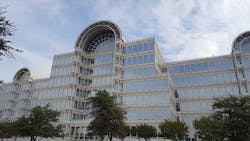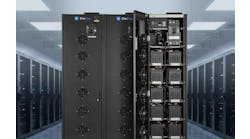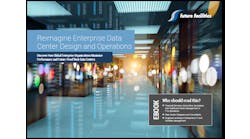One of the data center industry’s most iconic properties is getting a major makeover. Equinix says it will invest $138 million to expand the Dallas Infomart, the massive carrier hotel and interconnection hub on Stemmons Freeway.
Equinix will create a second data center alongside the existing Infomart, building a four-story structure on adjacent land that currently serves as a parking lot. The expansion will add 290,000 square feet of colocation space and 42 megawatts of power capacity alongside the Infomart, which at 1.6 million square feet is already one of the world’s largest multi-tenant data center hubs.
“We are going to start the journey to building out the Infomart as a campus, and I think that’s going to be a big opportunity for us,” said Equinix CEO Charles Meyers, adding that the expansion will support a strategic market.
The project illustrates the ongoing interest in carrier hotels, the downtown buildings that were emerged as connectivity hubs in the early days of the Internet, and continue as crucial network intersections. The Infomart expansion provides an unusual opportunity for a major expansion of a carrier hotel, which is rare due to the difficulty of adding new buildings in congested urban markets.
The Dallas Infomart is a key connectivity center in one of the nation’s busiest and most competitive markets. The Dallas data center market is home to 2.99 million square feet of commissioned data center space, which translates to 334 megawatts (MWs) of commissioned power, according to datacenterHawk. This makes the region the third-largest data center market for capacity in the U.S., behind Northern Virginia and Silicon Valley.
Creating A ‘Mega-Interconnection Campus’
Equinix is the world’s largest colocation provider, and acquired the Dallas Infomart for $800 million last year. The expansion brings the company’s investment in the property to nearly $1 billion.
The Infomart has always been a key facility for Equinix, which operates four data centers within the facility, providing a compelling incentive for Equinix to control the property. The Infomart deal also gave Equinix control of the two leading hubs for data traffic to Latin America, along with the NAP of the Americas in Miami, which it acquired when it bought a portfolio of Verizon data centers in 2017.
The new data center being built on the Infomart Campus will be DA11, and Equinix says it will be the first “high-rise flexible data center” (FDC) built to Equinix standards in the Americas.
“This is the first greenfield expansion on Infomart campus in more than 30 years, taking Equinix’s most unique competitive advantage – its high customer density interconnection platform – to the next level,” the company said in a statement. “This will turn the Infomart property into a mega interconnection campus and support content providers, enterprise, large footprint and premium retail all within a single facility.”
The expansion capacity on the Dallas site was one reason Equinix valued the property so highly.
“Being able to build contiguous to that space is going to be very important to us,” said Equinix CFO Keith Taylor at the time of the acquisition. “We believe we can drive immense intrinsic value to the business and to the shareholders by building out that capacity.”
Carrier Hotels Seek to Add Capacity
The Infomart is an early example of carrier hotels, buildings in the central business district of major cities that emerge as hubs for network connectivity, attracting dozens of providers. Carrier hotels became the early cornerstones of the Internet economy, and some of the most successful properties in the colocation industry.
A key piece of the business model is the meet-me room, a common area where providers can make connections between their networks. Interconnection facilities can be operated by building owners, non-profits or commercial service providers. As we noted in 2015, surging interest in interconnection has made carrier hotels sexy again.
The relevance of carrier hotels in the cloud era is reinforced by the recent efforts to add capacity at the most prominent buildings:
- A 2017 renovation at One Wilshire, the leading carrier hotel in Los Angeles, brought infrastructure upgrades that will add up to 28 megawatts of power capacity for the 30-story building, which houses 300 networks.
- Digital Realty has announced plans to expand of its huge data center at 350 East Cermak in downtown Chicago. Digital is seeking an anchor tenant to kick off development at 330 East Cermak, a 12-story data center that will provide low latency connections to the critical mass of networks providers housed next door.
- Equinix is investing $60 million in an expansion of the NAP of the Americas in Miami, the primary carrier hotel in south Florida. Equinix will build out the entire fifth floor, adding space for another 1,000 cabinets of colocation capacity.
- Last month DataGryd announced plans to build out new space within 60 Hudson Street, the most prominent carrier hotel in Manhattan. DataGryd’s MegaSuite 6 will offer data center suites within previously undeveloped space.
The expansion plans for those sites pale beside the potential expansion at the Dallas Infomart.
The atrium of the Dallas Infomart is modeled after the Crystal Palace in London. (Photo: Rich Miller)
Built in 1986 by legendary Dallas developer Trammell Crow, the Infomart’s distinctive glass facade was designed as a replica of the Crystal Palace built in London in 1850 as part of the first World’s Fair. The 1.58 million square foot property struggled for years to fulfill that vision, but found a niche in the early 1990s when it began leasing space to telecom tenants.
The building was used for trade shows, so it had ample parking space in a lot at the front of the building. That provides the opportunity to add another building. The four-story structure fits a trend in which companies are building taller data centers in markets with limited open land for development. Equinix has built an eight-story data center in Amsterdam, and just announced a seven-story project in Singapore.
Equinix says the new building will be a “logical extension” of the existing structure. Redevelopment plans under the previous ownership contemplated similar use of the parking lot, coupled with an expansion of an adjacent parking deck to replace lost parking capacity.
Then there is the future of the Infomart’s distinctive atrium, a large open space that rises seven floors and gets sunlight through the glass windows lining the rooftop. It’s a feature more common to commercial office buildings than multi-tenant data centers, which typically seek to optimize buildings to maximize the area dedicated to sellable data center space.
Equinix says it is focused on the new building, at least for now.
“We’re continuing to assess potential redevelopment and optimization of the Infomart floor plan, but to reduce disruptions to existing operations and current tenants, our near-term focus is on the new building,” said Equinix.






